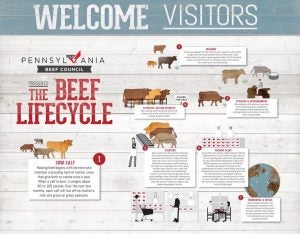Beef on dairy crosses (usually referred to as beef x dairy) are part of a practice where the beef and dairy industries collide. They have the potential to fill an opportunity for sustainable beef production, while providing benefits throughout the dairy and beef sectors. Collaboration along the whole food chain is necessary to reach the full potential of this practice.
Beef x dairy is when a dairy cow is bred to a beef bull to produce a half-beef/half-dairy calf. In the U.S., this practice has taken off over the past several years. From 2017 to 2021 domestic beef semen sales increased by over 6 million units to a record high of 8.7 million, while domestic dairy semen sales decreased by about the same amount. Much of this shift is seen in the increasing use of beef sires on dairy cows. This isn’t just a flash in the pan. It’s estimated that by 2024, there will be more than 3.7 million beef X dairy calves.
The connection between dairy and beef isn’t a new one. Dairy farms have been — and continue to be — an important supplier of beef through Holstein steers. These steers are very consistent, but less efficient than beef steers. Beef x dairy began as a way to add value to calves that would ultimately be grown, raised, and finished in a somewhat similar manner to beef steers.
So why use beef crossed with dairy? An important advantage of beef x dairy calves is that they’re more valuable from a beef perspective. Dairy and beef cattle have been bred for different purposes, and thus look different. Dairy cows have been bred to put more of the energy from their feed toward milk production. Beef cattle have been bred to efficiently put on muscle. Beef cattle have a “beefier” look and are more efficient converters of feed into meat. Dairy calves, even bull calves, are less efficient from a beef perspective as they still have the less “beefy” dairy genetics.
Crossing beef on dairy creates a calf with a “beefier” look that is more desirable and efficient for beef production. They also fetch higher prices.
Many dairy farms will breed their younger cows and top genetics to sexed semen, which has been sorted to contain only sperm carrying the X chromosome to only create only heifer (female) calves — at about 90 percent accuracy. A dairy farm only needs to raise so many heifers for the milking herd, so less genetically superior and older cows may be bred to beef bulls.
This helps to improve the overall genetics of a herd by focusing on the top genetics, while still keeping good cows in the herd that may have older, less superior genetics.
Deciding what beef bull to breed a cow to can be a challenge. Black Angus is a popular choice as it usually creates a “black hided” animal with “beefy” traits, which sells at a premium if it meets certain standards for Certified Angus Beef. Other beef breeds such as Limousin, Simmental, and Charolais are also popular choices for beef X dairy matings. It depends on what works best for the dairy farm and their calf buyers.
Some beef bull breeders and companies are working to identify and develop beef bulls specifically good for beef x dairy. Ultimately the goal is to breed a healthy calf with good feed efficiency and beef traits that will sustainably grow to harvest weight, while maintaining optimum calving ease (easy birthing) and fertility on the dairy end. This takes collaboration and communication between the dairy and beef sectors.
Another area that requires collaboration between all stakeholders in the food chain is animal welfare and calf management. Beef x dairy calves are typically sold to a calf grower and are raised in a similar manner to heifer calves on the dairy until about 400 to 600 pounds, before going to a backgrounder and/or eventually to a feedyard in a manner similar to beef cattle.

Beef x dairy calves need the same level of care including colostrum management, high-quality nutrition (milk and starter grain), and preventative veterinary care as their dairy counterparts. Animal welfare is both an ethical and a profitability necessity that go hand in hand. The calves are the future of the herd, so optimum calf care translates to a healthy productive cow on the dairy end, or in the case of beef x dairy a well-grown, healthy, and productive beef animal. This is a key point for all stakeholders.
Beef x dairy has the opportunity to fulfill the need for sustainable, efficient, and high quality beef production. Ultimately collaboration is key to reach the full potential of beef x dairy. High-quality genetics and animal care ensure that beef x dairy animals are meeting the needs of farmers, ranchers, packers, restaurants, retailers, and ultimately consumers. Communication of expectations and equitable incentives can help ensure the success of both dairy and beef producers along the beef x dairy supply chain.
Michelle Miller, the “Farm Babe,” is an internationally recognized keynote speaker, writer, and social media influencer and travels full time to advocate for agriculture. She comes from an Iowa-based row crop and livestock farming background and now resides on a timber farm in North Central Florida.



